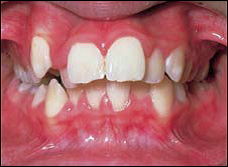Orthodontics
- Fixed Appliances (Braces) – Metal / Ceramic /Self-Ligating
- Invisible Braces
- Invisalign (On Request)
- Clear Aligners
- Lingual Braces
- Removable Appliances
- Myofunctional Appliances
- Minor Teeth Movements
- Surgical Orthodontics
- Naso-Alveolar Molding (NAM)
Orthodontics is the science of straightening and correcting teeth and any impaired (mismatched) growth of the jaws.



Who needs orthodontic treatment?
- Children as well as adults, are choosing to have orthodontic treatment for several reasons:
- Malocclusion
- Tooth Malalignment
- Unhappy with appearance of teeth
- During the preteen and teenage years, the jaws are growing and maturing; therefore it is easier to shift teeth at this stage rather than later on in adulthood.
- More adults are choosing to have orthodontic treatment in order to improve the appearance of their teeth. Since their jaws are no longer growing. Treatment may take a little longer.



What is Malocclusion?
Malocclusion is the improper positioning of the teeth and jaws. It is a variation of normal growth and development, which can affect the bite, the ability to clean teeth properly, gum tissue health, jaw growth, speech development and appearance.
Some Types of Malocclusion:
There are three basic categories of malocclusions.
- The first category consists of dental problems, in which the teeth (for various reasons) don't have the correct position on their osseous base (dentoalveolus), and as a result they appear crowded, spaced or rotated. Usually these problems are not visible when the mouth is closed,.
- The second category consists of skeletal problems, where the jaws have not grown harmoniously and that in turn has a negative effect on the function of the mouth and the esthetics of the face. In this category the goal of orthodontic treatment is to correct the position of the teeth and restore the balance of the face.
- Finally, in the third category the patient has a combination of dental and skeletal problems, which not only affect the oral cavity but also the esthetics of the face.



Why treat Malocclusion?
- Orthodontics is not only used to improve your appearance. The main purpose of treatment is to get teeth into proper occlusion so as to improve the overall stability of your oral cavity.
- Malocclusion or malaligned teeth can have long term effects, such as:
- Interference with normal growth and development of the jaws.
- Abnormal swallowing patterns
- Abnormal Facial Muscle function
- Impairment of chewing
- Speech defects
- Susceptibility to cavities due to the difficulty of removing plaque from crooked teeth.
- Vulnerability to accidents or fractured teeth (if your front teeth stick out, they may be more easily injured)
What are the goals of any orthodontic procedure? To create:
(Improved Appearance)
(Better chewing ability)
(Longer Lasting Teeth)




What do the braces do to the teeth?
Teeth can slowly be moved and shifted into proper position by applying pressure in certain directions.
- Bands, Wires and elastics are placed on the teeth to move them in the right direction. This takes place slowly and carefully over an extended period of time.
- Shifting teeth back into a functional position can take months to years, but eventually you will have a new and improved mouth and a longer lasting smile
- Retainers are often used after the braces, to hold the teeth in their new position until they are stable.
- It is important to wear the braces or an appliance for however long the dentist suggests. If you quit at any point during the treatment, the teeth can shift back into their old position.
Tips & Suggestions for maintaining your Braces
- Braces collect food and dental plaque very easily. If proper oral hygiene is neglected during orthodontic treatment both tooth decay and periodontal disease can occur easily.
- It is very important to maintain a daily plaque control program. Such a program may be as follows:
- A soft toothbrush should be used. A special orthodontic toothbrush can also be used to brush your teeth.
- Flossing with braces on takes more time than usual. Superfloss or floss threaders can aid in flossing, and make it more time efficient.
- An interdental brush can be used to fit between the wire and the tooth to remove hard-to-reach plaque and food debris.
- Oral irrigators can be used along with brushing and flossing. This helps remove food debris and plaque.
- A mouthwash containing fluoride can be used to help prevent cavities from occurring.
- Hard foods should be avoided since they can bend the wires, loosen the bands, or break the brackets (braces). Fruits and raw vegetables should be cut up into smaller pieces and chewed on the back teeth.
- Sticky foods such as chewing gum, hard candies, & toffees should be avoided as they can bend and break the wires and brackets.
- Foods high in sugar should also be avoided, since this increases the chances of tooth decay.
- Regular dental appointments are important to monitor the health of teeth and gums during orthodontic treatment.
- Orthodontics is lot of work and taking care of the braces is not easy, but in the end, the results will be worthwhile when you have your new and improved smile.
…and remember, be proud to give a silver smile!